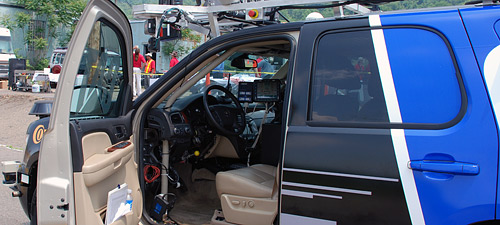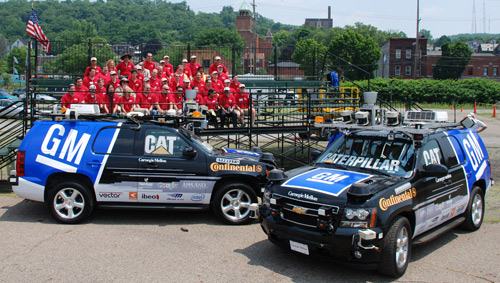As I mentioned in my post last Sunday, GM flew me out to Pittsburgh, PA last weekend to check out Carnegie Mellon's autonomous SUV compete in a DARPA site visit. The event determined whether CMU's robot named Boss would pass onto the national qualification event and then the final DARPA Urban Challenge in November, by presenting Boss a series of tasks.
 Carnegie Mellon's autonomous Tahoe navigating a course on its own.
Carnegie Mellon's autonomous Tahoe navigating a course on its own.
What's the point of this whole DARPA challenge?
The DARPA series of challenges is an initiative by the United States Department of Defense to develop technology that can be used in military and consumer vehicle applications in the near future. In 2001, Congress mandated that a third of the operational ground combat vehicles for the military should be unmanned by 2015. The Urban Challenge sprouted from that initial Congress mandate which authorized DARPA to dole out seed funding and prizes (1st place 2m, 2nd place 1m, 3rd place 500k) to participating teams. Carnegie Mellon University is only one of 53 teams (narrowed down from 89) competing in the DARPA Urban Challenge, although not all teams will make it to the final challenge.
In the past there have been two other DARPA Grand Challenges that, unlike the upcoming urban challenge, focused on traversing a desert route. As you might expect the urban challenge expects the autonomous vehicles to know how to deal with things like stop signs, traffic and finding a parking spot.
Meet Boss
Carnegie Mellon has two Chevy Tahoe DARPA SUVs that are pretty much identical in capabilities and technology. Only one vehicle may be used for DARPA but after talking with Carnegie Mellon's Tartan Racing leader Red Whittaker it became apparent how convenient it was for the team to have two vehicles to ease the development process.

Boss is no ordinary vehicle as you can tell by all the things sticking out of it. It has an E-85 burning 5.3L V8 modified with an 8kW belt-driven, under-hood generator. As such it sounds like it is supercharged, which I think is pretty cool. The generator is necessary given that Boss has 10 Intel Core 2 Duo blades running at 2.16GHz each.
 The server rack holding vital system components.
The server rack holding vital system components.
To keep up with the processing power, the air conditioning system has been augmented to keep computer systems cool. I got the chance to ride in Boss while it was driving itself and the back sounds like a data center with the cooling system running.

Boss totes 8 short range radar modules, 5 long range radar modules, 8 short range lidar (like a radar but uses lasers) modules, a mid range lidar module, 4 long range lidar modules, a forward-looking road detection module in addition to a few other sensors. Boss's maximum autonomous speed is 30MPH at the moment - a product of the limitation of its sensing and processing power. Compared to moving at highway speeds, Boss would have to be able to see further and think faster to plan its route. At the moment, Boss can evaluate over 1,000 objects per second.
Boss's sensors are used in conjunction with over 250,000 lines of custom code including perception software to generate moving and static obstacle models as well as behavioral software to make tactical decisions and negotiate traffic issues.
Event/Site Visit
The DARPA Event which took place last Monday, June 18th, was held at a place called Robot City, an abandoned area near Carnegie Mellon University that seemed to be used for steel industry work at one point. DARPA's site visit was made to check Boss's performance through four vehicle-capability tests; information which is used to determine whether Carnegie Mellon would advance to the national qualification event. The track was essentially a square with some stop signs and space for performing U-turns.
However, before the four tests, DARPA officials ensured that Boss could stop safely and remotely in the case of an emergency. During the actual tests no one is inside of Boss and it is completely unmanned. Cars do follow behind Boss with the ability to remotely stop it, but that's it. Inside and outside of Boss there are several big red emergency stop buttons as well. While not officially mentioned anywhere, I did notice that the Tartan Racing team upgraded Boss's brakes with some massive cross-drilled Brembo brakes. The brake upgrade is certainly justifiable though; with the added roll cage and computers, Boss weighs over 1,000lbs more than a stock version of the Tahoe.
Before the tests began, DARPA officials loaded a Mission Data File (MDF) via memory stick on Boss's computers and required that Boss be in autonomous mode and ready to begin the tests within 5 minutes of receipt of the MDF. The MDF contains a series of waypoints that must be visited by Boss in order, but does not have information about the route (that is evaluated and processed by Boss during the test). When unmanned and in autonomous mode, Boss activates flashing strobes and a siren for safety purposes.
Below are some pictures of Boss performing the DARPA tests. The tests included basic course navigation, passing stopped vehicles, maintaining distance between a car in front of it, stopping at stop signs with other vehicles present and proceeding in proper order, as well as performing U-turns.
 Boss performing a U-turn by itself as part of a DARPA-assigned task.
Boss performing a U-turn by itself as part of a DARPA-assigned task.
 Boss waiting for other cars to proceed while stopped at a stop sign.
Boss waiting for other cars to proceed while stopped at a stop sign.
 Boss passing a stopped car.
Boss passing a stopped car.
 Inside Boss, which is performing a U-turn on its own.
Inside Boss, which is performing a U-turn on its own.
 The two Boss Tahoes along with the Carnegie Mellon Tartan Racing team.
The two Boss Tahoes along with the Carnegie Mellon Tartan Racing team.
Results
While the official result has not been released, it is pretty much certain that Carnegie Mellon and Boss will be proceeding to the next event. Red Whittaker told me their performance on Monday was "impeccable" and could not have been any better had they been able to go back and change something.
After the tests, I was able to ride in Boss as it autonomously navigated the track. Boss did make two emergency stops as it noticed something in front, such as a cloud of dust, but overall I was thoroughly impressed that it was actually driving on its own. This really is a feat of technology and once the technology is perfected I would welcome it in consumer vehicles. Some of this technology is already present in vehicles - active cruise control and lane departure warning are prime examples. More so, a fully-realized example vehicle with this technology would be able to lessen the chance of automobile accidents.
Urban Challenge
The actual Urban Challenge, the culmination of each team's work, will take place November 3rd at a yet to be disclosed location. It will be a 60-mile race simulating an urban environment and the autonomous robots must safely conduct simulated battlefield supply missions and obey traffic laws while merging into traffic, navigating intersections and avoiding obstacles. The robots that complete the course in fewer than 6 hours win. Prizes are awarded based on times and only the top three receive prizes.
Video
My friend (i)Justine was in attendance at this DARPA site visit and created a video you might find interesting. I make an awkward appearance in the video too.